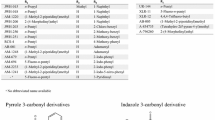Abstract
To examine the impact of the second legal ban on synthetic cannabinoids (SCs) in the UK in February 2013, we surveyed the UK legal high market just before and after the change in legislation, looking for new SCs. The technique gas chromatography–mass spectrometry (GC–MS) in electron ionization mode, most widely applied for analysis, was found to be insufficient for the identification of several SCs, and therefore liquid chromatography–high-resolution mass spectrometry (LC–HR-MS) was required. LC–HR-MS(/MS) measurements of the protonated molecules and product ions allowed the detection of up to 27 compounds as the third-generation SCs in the samples analysed as part of this study, including two unknown compounds that were tentatively identified as F2201 and dealkyl-SDB-006. Our results showed that banned compounds were removed from the market on the day when the ban was in place, and were replaced by other SCs immediately after the ban. In only one occasion, a banned compound (UR-144) was detected after the date when the new legislation came into place. It is also noteworthy that regardless of the change in legislation, new compounds continued to enter the market. Product ion spectral information on the third-generation SCs at different collision energies given in this paper will be of help for forensic and clinical laboratories and will facilitate the detection and identification of new SCs by laboratories of control. This information is very valuable for law enforcement and policymakers and will be of help in future prevention programs.











Similar content being viewed by others
References
Uchiyama N, Kikura-Hanajiri R, Kawahara N, Haishima Y, Goda Y (2009) Identification of a cannabinoid analog as a new type of designer drug in a herbal product. Chem Pharm Bull 57:439–441
Auwärter V, Dresen S, Weinmann W, Müller M, Pütz M, Ferreirós N (2009) ’Spice’ and other herbal blends: harmless incense or cannabinoid designer drugs? J Mass Spectrom 44:832–837
Uchiyama N, Kikura-Hanajiri R, Kawahara N, Goda Y (2009) Identification of a cannabimimetic indole as a designer drug in a herbal product. Forensic Toxicol 27:61–66
Tsujikawa K, Yamamuro T, Kuwayama K, Kanamori T, Iwata YT, Inoue H (2014) Thermal degradation of a new synthetic cannabinoid QUPIC during analysis by gas chromatography–mass spectrometry. Forensic Toxicol 32:201–207
Uchiyama N, Kikura-Hanajiri R, Goda Y (2010) Chemical analysis of synthetic cannabinoids as designer drugs in herbal products. Forensic Sci Int 198:31–38
Shanks KG, Dahn T, Behonick G, Terrell A (2012) Analysis of first and second generation legal highs for synthetic cannabinoids and synthetic stimulants by ultra-performance liquid chromatography and time of flight mass spectrometry. J Anal Toxicol 36:360–371
Ibáñez M, Bijlsma L, van Nuijs ALN, Sancho JV, Haro G, Covaci A, Hernández F (2013) Quadrupole-time-of-flight mass spectrometry screening for synthetic cannabinoids in herbal blends. J Mass Spectrom 48:685–694
Penn HJ, Langman LJ, Unold D, Shields J, Nichols JH (2011) Detection of synthetic cannabinoids in herbal incense products. Clin Biochem 44:1163–1165
Grabenauer M, Krol WL, Wiley JL, Thomas BF (2012) Analysis of synthetic cannabinoids using high-resolution mass spectrometry and mass defect filtering: implications for nontargeted screening of designer drugs. Anal Chem 84:5574–5581
Hudson S, Ramsey J, King L, Timbers S, Maynard S, Dargan PI, Wood DM (2010) Use of high-resolution accurate mass spectrometry to detect reported and previously unreported cannabinomimetics in “herbal high” products. J Anal Toxicol 34:252–260
Gottardo R, Chiarini A, Dal Prà I, Seri C, Rimondo C, Serpelloni G, Armato U, Tagliaro F (2012) Direct screening of herbal blends for new synthetic cannabinoids by MALDI-TOF MS. J Mass Spectrom 47:141–146
European Monitoring Centre for Drugs and Drug Addiction (2015) EMCDDA presents latest update on ‘new drugs’ from EU Early Warning System. http://www.emcdda.europa.eu/news/2015/1/cnd-new-drugs. Accessed April 2017
The Misuse of Drugs Act 1971 (Amendment) Order 2013, 2013 No. 239. Dangerous Drugs. http://www.legislation.gov.uk/uksi/2013/239/pdfs/uksi_20130239_en.pdf. Accessed April 2017
Kikura-Hanajiri R, Uchijama N, Kawamura M, Goda Y (2014) Changes in the prevalence of new psychoactive substances before and after the introduction of generic scheduling of synthetic cannabinoids in Japan. Drug Test Anal 6:832–839
Acknowledgements
Several products for this study were provided by police forces and drug workers. Samples from Essex Police, Kent Police and Lifeline Project Ltd. were used for this work and they are gratefully acknowledged. Bram Miserez forms a part of the EU-International Training Network SEWPROF (Marie Curie-FP7-PEOPLE grant #317205), and the financial support of the European Union is gratefully acknowledged. Lubertus Bijlsma acknowledges NPS-Euronet (HOME/2014/JDRUG/AG/DRUG/7086), co-funded by the European Union, for his post-doctoral fellowship. This publication reflects the views only of the authors, and the European Commission cannot be held responsible for any use which may be made of the information contained therein. The authors acknowledge the financial support from Generalitat Valenciana (Group of Excellence Prometeo II 2014/023) and from the Ministerio Español de Economía y Competitividad (Project CTQ2015-65603-P).
Author information
Authors and Affiliations
Corresponding author
Ethics declarations
Conflict of interest
The authors declare that they have no conflicts of interest.
Ethical approval
This article does not contain any studies with human participants or animals performed by any of the authors.
Additional information
María Ibáñez is also the co-first author for this article.
Electronic supplementary material
Below is the link to the electronic supplementary material.
Rights and permissions
About this article
Cite this article
Bijlsma, L., Ibáñez, M., Miserez, B. et al. Mass spectrometric identification and structural analysis of the third-generation synthetic cannabinoids on the UK market since the 2013 legislative ban. Forensic Toxicol 35, 376–388 (2017). https://doi.org/10.1007/s11419-017-0368-7
Received:
Accepted:
Published:
Issue Date:
DOI: https://doi.org/10.1007/s11419-017-0368-7




